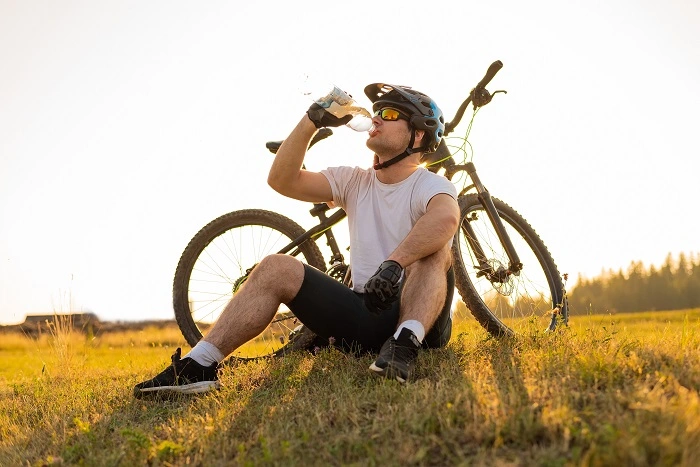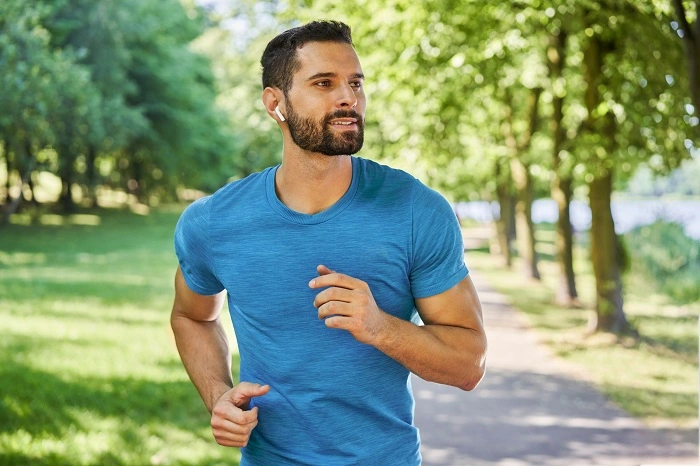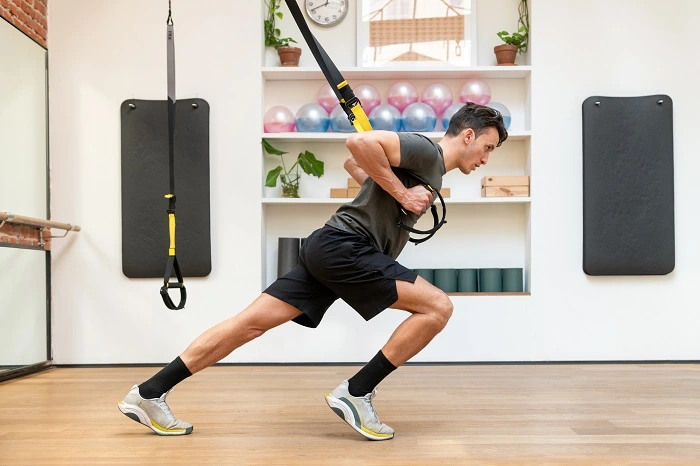Swimming
Evokes movement, focus, and achievement
Cycling
Connects skill development with well-being
Tennis
Game, Set, Match Your Fitness Goals
Running
Emphasizes personal growth and steady progress
Strength training
Focuses on physical capability and self-belief
Incorporating regular physical activity into your life will help reduce your risk of developing chronic diseases and make you healthier overall. However, most Americans only sit around. Increased physical activity benefits people of all ages and abilities. Furthermore, suppose pain, a long-term disease, or limited movement prevent you from leading a more active lifestyle. In that case, a physical therapist can assist you in overcoming these obstacles and returning to exercise.
Living abroad can make it challenging to stick to a fitness routine. On the other hand, the unconventional setting may encourage more individuals to attempt a new sport. But what's the healthiest way to exercise? This question is difficult to convey. On the Internet, you can receive a variety of rankings.
Here is a list of five emotionally and physically beneficial games that do not pose a high risk of injury. The order of the sports doesn't matter.
Top 5 Health and Sports activities
Swimming
Evokes movement, focus, and achievement
 Swimming is great for your heart. Also, it is a pleasant activity. As an added bonus, it helps you maintain a healthy weight by burning calories, growing muscle, and improving your lung capacity. You can swim anytime you want, which is the best part of having an indoor pool. Swimming is an excellent way to work out since it engages every muscle in your body.
Swimming is great for your heart. Also, it is a pleasant activity. As an added bonus, it helps you maintain a healthy weight by burning calories, growing muscle, and improving your lung capacity. You can swim anytime you want, which is the best part of having an indoor pool. Swimming is an excellent way to work out since it engages every muscle in your body.
Advantages of Swimming
- Improved cardiovascular health
- Enhanced flexibility and strength
- Reduced anxiety and stress
- Improved sleep
- Joint-friendly, low-impact physical activity
- Engaging all major muscle groups for a full-body workout.
Disadvantages of Swimming
- Increased risk of overuse injuries, such as swimmer's shoulder
- Exposed to chlorine and other pool chemicals, causing skin and respiratory irritation.
- Swimming alone or without supervision or safety gear increases the risk of drowning.
- Swimming requires time and access to a pool or body of water.
Cycling
Connects skill development with well-being
 A bike ride is a beautiful way to lose weight while also relaxing. Riding with someone else makes biking more enjoyable. Cycling is an excellent way to burn calories without overworking your body. It also increases your happiness and mental strength. Cycling is a popular form of exercise that provides numerous benefits. But before you join the crowd, consider what could go wrong. Here are some of the primary advantages and disadvantages of riding as a sport:
A bike ride is a beautiful way to lose weight while also relaxing. Riding with someone else makes biking more enjoyable. Cycling is an excellent way to burn calories without overworking your body. It also increases your happiness and mental strength. Cycling is a popular form of exercise that provides numerous benefits. But before you join the crowd, consider what could go wrong. Here are some of the primary advantages and disadvantages of riding as a sport:
Advantages of Cycling
- Maintaining Good Heart Health
- Having a low-impact
- Enhances Muscle Strength
- Diet and Exercise for Weight Loss
- Reduce stress, anxiety, and depression
- Convenience
Disadvantages of Cycling
- Increase Risk of Injury and accidents
- Outdoor cycling is highly dependent on the weather.
- Pollution & Traffic
- Expenses for Equipment and Upkeep
- Suffering from Back Pain
Tennis
Game, Set, Match Your Fitness Goals
 Tennis is a great aerobic activity that burns 600 calories per hour, similar to running and cycling. You must concentrate your strength and energy on short, powerful bursts to execute all of tennis's little sprints, pivots, slams, and serves. Playing tennis regularly throughout your life has numerous health and well-being benefits. Despite the benefits to your body, mind, and social life, there are also associated expenses and risks. If you've never played tennis before, consider the benefits and drawbacks before deciding whether it's the perfect sport.
Tennis is a great aerobic activity that burns 600 calories per hour, similar to running and cycling. You must concentrate your strength and energy on short, powerful bursts to execute all of tennis's little sprints, pivots, slams, and serves. Playing tennis regularly throughout your life has numerous health and well-being benefits. Despite the benefits to your body, mind, and social life, there are also associated expenses and risks. If you've never played tennis before, consider the benefits and drawbacks before deciding whether it's the perfect sport.
Advantages of Tennis
- Improving your fitness level,
- Making new friends,
- Encouraging healthy competition
- Your health will improve
- You can disconnect
- Approach to alleviating stress
- Enhanced Reflexes
- Your confidence may soar if you play tennis.
Disadvantages of Tennis
- Possible catastrophic harm
- Tennis gear isn't cheap.
- Does not include a team
- You need a partner to play tennis.
- It takes time to learn tennis.
- Lack of motivation.
- Time-consuming
- Pressure levels can differ
- It could affect your career in corporate America
- Skill has a significant role
Running
Emphasizes personal growth and steady progress
 Regular walkers lose bones and muscles slower than people who exercise infrequently or never. In other words, running is more than just a sport for children and teenagers. When the body experiences stress, the bones develop and strengthen. It improves your mental and physical well-being. Running releases endorphins, the chemicals responsible for the "runner's high."
Regular walkers lose bones and muscles slower than people who exercise infrequently or never. In other words, running is more than just a sport for children and teenagers. When the body experiences stress, the bones develop and strengthen. It improves your mental and physical well-being. Running releases endorphins, the chemicals responsible for the "runner's high."
Advantages of Running
- Stronger Bones and Muscles
- Improves Mental and Physical Health
- Improves cardiovascular fitness, endurance, and stamina.
- Burns calories effectively, aiding in weight maintenance.
- Convenience
- Social Interaction
Disadvantages of Running
- Risk of Injury
- Impact on Joints
- Time Commitment
- Mental Strain
- Weather Dependency
- Running outdoors may contribute to environmental degradation,
Strength training
Focuses on physical capability and self-belief
 Strength training is beneficial for everyone because it strengthens the muscles. It's not just for sports. You can mow the lawn or simply get out of a chair with little effort. Here are some of the most effective moves for power training:
Strength training is beneficial for everyone because it strengthens the muscles. It's not just for sports. You can mow the lawn or simply get out of a chair with little effort. Here are some of the most effective moves for power training:
- Pull-ups: Because you utilize your body weight as resistance, pull-ups work a wide range of muscles. The back and arms are the primary muscles that you work. Even if they are difficult at first, as you see results and try to build muscle, you will improve and feel better.
- Push-Ups: There are several approaches to making push-ups more straightforward to perform. They exercise the chest, shoulders, and forearms. Push-ups, whether performed standing or crouching, increase your strength and confidence.
- Squats: These will help you feel better about your physique and increase the power in your legs. Squatting, whether with weights or your body weight, works your core, quadriceps, and hips. This helps you feel strong and capable.
- Deadlifts: You must perform deadlifts to learn how to carefully lift large objects. They strengthen your core, hamstrings, and hips while providing a sensation of success.
- Planks: A plank exercise strengthens your core, upper body, and lower body. Improve your plank pose to boost your confidence and posture.
Advantages of Strength Training
- Makes you stronger
- Promotes efficient calorie burn
- Reduces fat in the abdomen area
- Makes you look slimmer
- Reduces the possibility of falls
- Maintains a healthy heart
- Assists with glucose control
- Encourages more freedom of movement and adaptability
- Lifts your confidence
- Strengthens bones
- Enhances your disposition
- Enhances cognitive function
Disadvantages of Strength Training
- Risk of Injury
- Time Commitment
- Equipment Costs
- Muscle Soreness
- Plateaus
- Being overworked
- Specialized Knowledge
- Lack of Muscle balance
Benefits of Physical Activity and Sports
We are still determining what we would do without gaming. Sports not only offer us energy, but they also improve our physical and mental health. A daily sports regimen might help you gain strength and boost your self-confidence. According to a WHO report, those who do not engage in regular physical activity are 20–25 percent more likely to die.
You should participate in sports every day because of the following ten reasons:
- Being active daily strengthens the heart and improves its ability to pump blood throughout the body.
- It helps the lungs perform more efficiently by allowing them more oxygen.
- Being physically active can boost your self-esteem and open new career opportunities.
- Being physically active can help you sleep better.
- Sports can benefit everyone in various ways, including physical, mental, and social interaction.
- Participating in sports fosters lifelong character and leadership abilities.
- Through teamwork, sports unite people of many faiths and castes.
- Physical activity can help reduce tension and anxiety.
- Playing sports can help a person become more resistant to germs.
- Daily physical activity can also help to decrease cholesterol levels.
What are the top 5 fitness components?
The following domains contribute to physical fitness:
- Muscular Strength: Lifting capacity directly correlates with muscular strength or the power your muscles can produce.
- Cardiovascular endurance: Performing at a high heart rate for extended periods.
- Body Fat Composition: Analysing your body fat composition will reveal more about your body fat proportion and its relationship to overall mass.
- Balance and Coordination: You require balance if you can stand up straight and demonstrate control over your body, and coordination if you can move your body parts quickly and accurately.
- Flexibility: the ability to lengthen one's muscles without causing them to pull or tear.
1. Muscular Strength.
The Building Blocks of Fitness Muscle strength is defined as the weight you can lift or the force your muscles can withstand. To determine this, one technique is to guess their "one rep max," which is the heaviest weight they can lift at once. It signifies that the weight is as hefty as the muscles can lift without injury. Programs focusing solely on improvement will maintain work sets within a specified range of this value.
2. Cardiovascular Endurance
Cardiovascular endurance measures a person's ability to handle and recover from strenuous physical activity. One aspect of this is maintaining a high heart rate for extended periods. Your VO2 Max is the quantity of oxygen your muscles can consume and absorb at their peak during exercise. Many athletes, such as marathon runners, sprinters, combat athletes, and swimmers, require cardiovascular endurance training.
3. Body fat composition
When individuals think about body fat composition, they frequently refer to it as the ratio of fat mass to total body mass. This measurement accounts for the quantity of body fat around your muscles and organs. People commonly use calipers to measure the fat fold on the chest, abdomen, and thighs, separating the muscle fibers from the fat. According to the National Collegiate Athletic Association, a healthy adult male's average body fat percentage ranges from 10 to 22%, while a healthy adult female's average body fat percentage is 20–32%. This depends on height, weight, and other hereditary characteristics.
4. Balance and coordination.
Equilibrium is maintaining your equilibrium while demonstrating control over your body. In contrast, coordination is the ability to regulate the movements of your body parts with ease and precision. Your ability to balance directly correlates with the strength of your stabilizing muscles. To test this, stand on one leg for an extended period without trembling or utilizing the other for support. One way to assess if someone has strong coordination is to observe how readily and effectively they move their body. People who can coordinate their motions are expert dancers.
5. Flexibility
Flexibility is best defined as the capacity to stretch your muscles without injuring them when determining how fit someone is. To measure this, you must stretch your muscles in various ways until they are as long as they can go without causing pain. Flexibility is highly crucial in sports and martial arts. Growth pushes different muscle groups to their limits, making it critical to develop strength across the entire range of motion to avoid injury.
FAQs
Which exercise can you do every day?
As a general guideline, you should rest your muscles and heart between strenuous activities. However, if you want to exercise for 300 minutes weekly, you can do a few light workouts daily. Examples of these activities include walking, biking, dancing, and skating.
What exercises are good for belly fat?
The British Heart Foundation asserts you cannot burn fat in a specific body area. You may burn fat anywhere in your body if you follow a regimen incorporating aerobic exercise, weight training, and a healthy diet. You can undertake a variety of workouts, including rock climbing, swimming, yoga, jogging, and strength training.
Conclusion
People who want to enhance their health and reduce their chance of developing chronic diseases should engage in physical activity daily. Even though most Americans do not participate in much physical activity, it can benefit people of all ages and abilities.
Numerous sports and outdoor activities are beneficial for you. Swimming, cycling, tennis, jogging, and strength training are examples. These activities help to achieve a wide range of fitness goals. They boost cardiovascular health, increase strength and flexibility, improve sleep quality, and make you happy. Everything has advantages and disadvantages, but regular exercise and sports benefit your health in various ways, including enhancing your heart and lungs, boosting your confidence, allowing you to form stronger connections with people, and making you feel better about life in general.
Everyone should engage in exercise regularly because it is beneficial to their health. Even if people cannot exercise, playing physical sports outside would benefit their body and mind. In today's fast-paced society, where everyone is focused on making money, exercising or engaging in other hard work is critical. Working out is essential for keeping your mind relaxed and your attitude upbeat.






